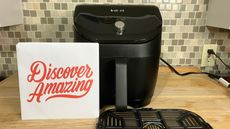

Knowing the top kitchen cleaning mistakes is crucial if you want a gleaming kitchen that not only looks great, but also ensures a hygienic environment for preparing meals.
Our industry expert reveals the five most common kitchen clangers, along with top tips on how to avoid them. Using the same sponge for long periods of time and assuming your dishwasher is clean are just a few of these.
When it comes to cleaning a kitchen, it pays to be aware of potential pitfalls that can undermine your efforts, helping you achieve a sanitized, sparkling space.
Swerve these common kitchen cleaning mistakes
So many of the most common cleaning mistakes occur in the kitchen. Thankfully, this expert guide will help you get yours both beautiful and bacteria-free.
From overusing sponges to neglecting the dishwasher, our industry pro reveals the top five kitchen cleaning mistakes to avoid, alongside top tips for what to do instead.
Where our expert has suggested products, we've sourced high-quality items from trusted retailers.
The prices below were correct at the time of publishing this article.
1. Using the same sponge for too long
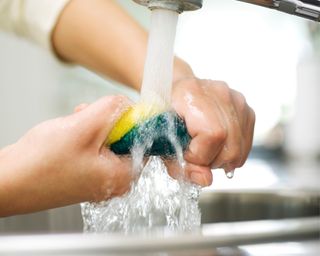
Sponges are kitchen workhorses, used for everything from wiping countertops to scrubbing dishes. However, they are also notorious for harboring bacteria. Using the same sponge for an extended period can spread germs around your kitchen rather than removing them.
Karina Toner, operations manager at Spekless Cleaning, says, "Overusing your sponges means you're basically spreading bacteria around your kitchen.
"I always advise replacing sponges frequently — at least every two weeks. Alternatively, use a sponge that can be sanitized in the dishwasher or microwave."
Karina recommends the Scrub Daddy Sponge from Amazon. She adds, "These sponges are durable, can be sanitized in the dishwasher, and change texture based on water temperature for versatile cleaning."
Our Real Homes content editor Eve Smallman swears by her Scrub Daddy and uses it for scrubbing difficult-to-clean dishes and pans. It's also one of our top cleaning supplies we've tried here at Real Homes.
Establishing a routine for sponge cleaning and replacement will help keep harmful bacteria at bay and allow you to maintain a hygienic kitchen.
2. Assuming your sink is clean with regular use
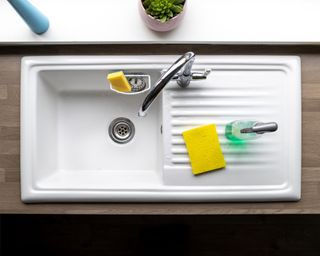
It's easy to assume that because water and soap are frequently running through your sink, it remains clean. However, the sink is one of the dirtiest places in the kitchen, often more contaminated than your toilet. Food particles, bacteria, and grime can build up in the sink and around the drain.
Karina says, "Your sink can all-too-easily become a breeding ground for bacteria from raw food and dirty dishes.
"It's important to remember that regular use and exposure to dishwashing soap does not eliminate bacteria and grime that accumulate from food particles and dirty dishes.
"Instead of relying on regular dishwashing, scrub the sink with a disinfectant cleaner at the end of each day and rinse it thoroughly after washing dishes to prevent buildup and odors."
Karina recommends the Bar Keepers Friend Cleanser from Target, adding, "This cleanser is excellent for tough stains on stainless steel, ceramic, and porcelain surfaces."
A mixture of baking soda and vinegar also works well. The Good & Gather Baking Soda from Target is a reliable option, while the Aunt Fannie's Cleaning Vinegar from Amazon has 6% acidity and comes with great reviews.
I love cleaning with vinegar around the house, as it's a budget-friendly and sustainable option.
Don't forget to clean the faucet and handles, as these areas are frequently touched and can harbor germs.
3. Overlooking the tops of cabinets

Out of sight, out of mind — this adage often applies to the tops of cabinets and the refrigerator. But it's important they're on your kitchen cleaning checklist, as ignoring them can lead to a buildup that is not only unsightly, but can also attract pests.
Karina says, "Though they're easy to forget and also a hassle to get to, dust and grease can accumulate in these hard-to-reach areas.
"Use a step stool to reach and clean them every few months with a degreasing cleaner like Goo Gone Kitchen Degreaser from Amazon. This cleaner is specially formulated to break down grease and sticky residues in the kitchen, leaving surfaces clean and shiny without much elbow grease."
4. Forgetting to disinfect cutting boards
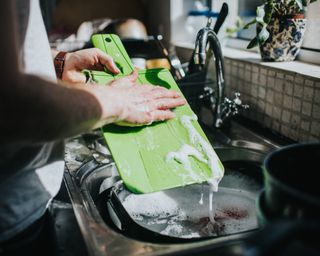
Cutting boards are essential kitchen tools, but they can also be a breeding ground for bacteria, especially if used for both raw meat and vegetables. Simply rinsing them with water after use is not enough.
Karina says, "Disinfect cutting boards after each use by mixing water and bleach, then follow up with a disinfecting wipe. Ensure the cutting boards are thoroughly air-dried before storing them."
Create a solution of one tablespoon of unscented liquid chlorine bleach per gallon of water. The Clorox Splash-less Liquid Bleach from Target comes in a thicker formula for less splash.
Alternatively, you can use white vinegar or hydrogen peroxide. The gallon of Heinz White Vinegar from Walmart is good quality and will last you a good while.
Karina recommends Clorox Disinfecting Bleach-Free Cleaning Wipes from Target. These wipes are convenient and effective for quickly disinfecting cutting boards after use, killing 99.9% of bacteria and viruses, making them a reliable choice for kitchen sanitation.
Wooden cutting boards require extra care; apply a food-grade mineral oil periodically to maintain their condition and prevent cracks where bacteria can hide.
Karina adds, "For even better food safety, use separate boards for raw meat and other foods to avoid cross-contamination."
5. Assuming your dishwasher is clean with regular use
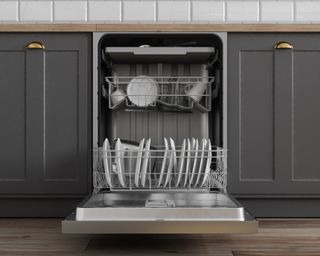
A dishwasher cleans dishes, so it must clean itself, right? Unfortunately, this is not the case. Over time, food particles, grease, and soap scum can build up inside the dishwasher, leading to unpleasant odors and less effective washing up. So, it's a good idea to learn how to clean a dishwasher properly.
Karina says, "Firstly, make sure you're regularly cleaning the filter — usually located at the bottom of the machine. Use a microfiber cloth along with warm, soapy water to ensure it's totally clean and free from food remnants.
"Next, run a monthly cleaning cycle with a dishwasher cleaner to remove buildup and maintain a fresh, clean appliance."
Karina recommends these Affresh Dishwasher Cleaner Tablets from Amazon. She says, "These are specifically designed to remove limescale and odor-causing residues from your dishwasher, ensuring a clean and efficient appliance. They can be used monthly for maintenance and are safe for use with dishwashers."
Alternative cleaning options include running an empty cycle with a cup of white vinegar on the top rack once a month to help break down food residue and remove odors. For an extra deep clean, sprinkle a cup of baking soda across the bottom of the dishwasher and run another empty cycle. These are a just a couple of our creative dishwasher cleaning hacks.
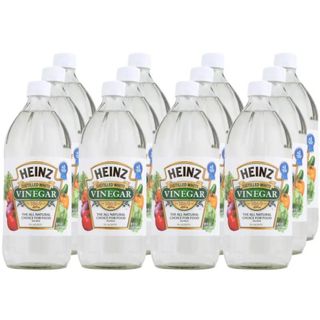
Size (fl oz): 32 / bottle
Price: $74.49
This high-quality vinegar is a great natural cleaning agent, tackling stains and odors. The case includes twelve 32 fluid-ounce bottles so you'll always have a steady supply.
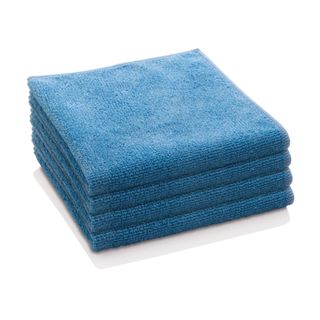
Size (inches): 0.2H x 13W
Price: $19.99 for four
Reusable and backed by a three-year or 300-wash guarantee, these precision-engineered microfiber cloths attract and trap grease, grime, fingerprints, and over 99% of bacteria.
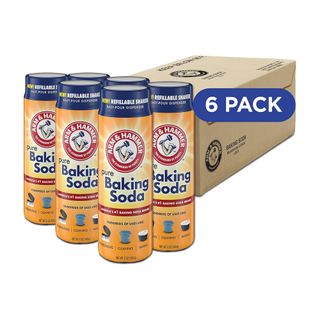
Size (fl oz): 12
Price: $14.94
This pack of baking soda will last for ages and refresh everything from dishwashers to dirty carpets. The dual-sided dispenser makes application easy.
Meet our expert

Karina Toner is operations manager at Spekless Cleaning, which prides itself on exceptional cleaning, professionalism and client satisfaction. With over a decade of hands-on experience in the cleaning industry, Karina specializes in providing expert, tailored advice for clients on natural cleaning methods that prioritize both effectiveness and sustainability.
By avoiding these common kitchen cleaning mistakes, you can maintain a cleaner, more hygienic kitchen and ensure it remains a safe and pleasant place to prepare meals.
Got your rubber gloves on and want to carry on cleaning? It's also worth finding kitchen cleaning hacks for more tips and tricks.
Join our newsletter
Get small space home decor ideas, celeb inspiration, DIY tips and more, straight to your inbox!

I'm a senior writer with an English degree and NCJ qualification, plus years of experience writing news, lifestyle and consumer articles for the national and international press. I'm also a copywriter, working on a breadth of consumer and corporate projects, and a private education consultant. I live in the quiet of the countryside and love completing DIY tasks to breathe life into my small, newly-built home.

